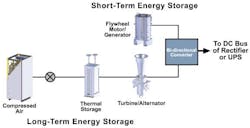Since the late 1990s, flywheel energy storage systems have been sold as environmentally friendly alternatives to lead-acid batteries for providing backup power to uninterruptible power supply (UPS) systems.
But flywheel systems—which store kinetic energy proportional to the speed and mass of a spinning disk—are typically designed to provide only about 15 seconds of full-load power. This means that flywheels are well-suited to handle the vast majority of power disturbances, which last for five seconds or less. But for longer power outages, flywheel storage systems must typically be used in combination with batteries or with fuel-fired generators.
Three in one
Now, however, one maker of flywheel energy storage systems has combined flywheel technology with two other environmentally benign energy storage technologies—compressed air and thermal storage—to come up with a longer-term backup power solution. The CoolAir system developed by Austin, Texas-based Active Power Inc. can deliver battery-free backup power for periods measured in minutes or hours, says Jim Clishem, Active Power president and chief operating officer.
Active Power’s CoolAir system is based on what the company calls TACAS, for Thermal and Compressed Air Energy Storage. TACAS starts with compressed air stored at 4,500 pounds per inch in standard cylinders that are maintained at full capacity by an onsite compressor. The compressed air cylinders are connected to an insulated thermal storage unit, which includes air passages within a stainless steel core that is heated and maintained at 1300 degrees Fahrenheit. A third component is a small, constantly spinning flywheel.
During short power disturbances, the flywheel provides backup power to a UPS. But when an extended outage is detected, the compressed air is released into the thermal storage unit, where it picks up additional thermal energy. This heated air then drives a small, expansion turbine/alternator that spins at 70,000 revolutions per minute (rpm) to generate backup power for the UPS for an extended period proportional to the energy available. About two-thirds of the energy comes from the thermal storage and the remainder from the compressed air, Clishem says. The flywheel provides a “bridging” energy source during the approximate one-second period required for the turbine/alternator to reach full operating speed.
Green solution
“This is a completely new and different concept to generate electricity using environmentally friendly components,” says Clishem. Unlike toxic, lead-acid batteries, there are no hazardous by-products or disposal issues with TACAS, he points out. And while batteries require regular maintenance, degrade with use and must be replaced every three to five years, the TACAS-based system features low maintenance and is completely renewable over a 20-year lifespan, Clishem contends.
Also unlike batteries, which require a tight ambient temperature range of 20 to 25 degrees Celsius, the TACAS system has a wide operating temperature range of 0 C to 40 C—an advantage for use in rugged factory environments, says Clishem. The TACAS-based CoolAir system also takes its name from an added bonus that comes along with the technology; because the system’s turbine extracts heat energy from the compressed air stream, the system exhaust consists of cooled, breathable air tuned to 59 F, which is suitable for cooling data center environments. “This is the first system in the world that provides both backup transition power and backup transition cooling at the same time,” Clishem claims.
A CoolAir DC system requires a footprint about 31.5 inches square, and can be used with any vendor’s UPS or with ActivePower’s own CoolAir UPS system. Maximum output per unit is 80 kilowatts, providing backup power of up to 15 minutes, and up to eight CoolAir UPS units can be paralleled together for increased power capacity.
Backup service
Active Power is marketing the CoolAir technology as an environmentally friendly, battery-free solution for UPS applications. And while it’s nice to be “green,” Clishem notes, the company also realizes that any environmentally friendly system must also make economic sense. That’s one reason that the CoolAir system is being offered not only as a product for sale, but also on a service contract basis, he says.
“Our CoolAir systems are a little more expensive than batteries up front, if you were to purchase them,” Clishem concedes. “But the usage model is always cheaper than batteries over its life cycle, at any point during our three-, five- or 10-year contracts.”
About the Author
By Wes Iversen
Managing Editor

Leaders relevant to this article:
